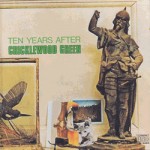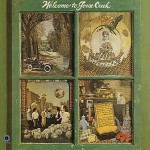|
|
I’m not a huge fan of blues music. Although I recognize its influence, it tends to strike me as somewhat formulaic and predictable. There are exceptions, though, and fairly close to the top of that list would be Cricklewood Green, a 1970 release by Ten Years After. While I don’t remember how it ended up in my collection, I listened to it frequently throughout high school and have since.
What does that have to do with his post or its title? Well, every song on the LP was written by Alvin Lee, the group’s founder, lead guitarist and singer, including my favorite, “50,000 Miles Beneath My Brain.” Lee died Wednesday at age 68 of “unforeseen complications of a routine surgical procedure.” Given the album’s association with my youth, I was quite saddened when I heard the news on the radio on my way home that night. And what did I do before the night was over? Listen to the album.
 Ten Years After probably became best known in the U.S. after its performance of “I’m Going Home” during its encore at Woodstock. The song, which made it to both the album and the film, is a taste of what I liked about Alvin Lee and the band. It is an outright blues piece that serves as the basis of an extended guitar jam by Lee. That’s why I think “50,000 Miles Beneath My Brain” is my favorite song on Cricklewood Green. With a little bit of studio contrivance at the beginning, the song simply builds into a tremendous jam. The same is true of “Love Like A Man” on (what was then) the album’s flip side. Most of the balance of the album is 12-bar blues rock, where the blues is a foundation for the superstructure Lee creates with his guitar. Ten Years After probably became best known in the U.S. after its performance of “I’m Going Home” during its encore at Woodstock. The song, which made it to both the album and the film, is a taste of what I liked about Alvin Lee and the band. It is an outright blues piece that serves as the basis of an extended guitar jam by Lee. That’s why I think “50,000 Miles Beneath My Brain” is my favorite song on Cricklewood Green. With a little bit of studio contrivance at the beginning, the song simply builds into a tremendous jam. The same is true of “Love Like A Man” on (what was then) the album’s flip side. Most of the balance of the album is 12-bar blues rock, where the blues is a foundation for the superstructure Lee creates with his guitar.
 I don’t think any of the individual tunes from Cricklewood Green hit the charts in the U.S. The album, though, hit number 14 on the Billboard charts, the highest charting album the band had. The next year “I’d Love To Change The World” (also written by Lee and perhaps my single favorite of the band’s work) reached the Top 40 and the album, A Space in Time hit number 17. I don’t think any of the individual tunes from Cricklewood Green hit the charts in the U.S. The album, though, hit number 14 on the Billboard charts, the highest charting album the band had. The next year “I’d Love To Change The World” (also written by Lee and perhaps my single favorite of the band’s work) reached the Top 40 and the album, A Space in Time hit number 17.
Ten Years After split up in 1974. Lee released a couple albums in the late 1970s with a band he called “Ten Years Later” but he’s spent most of his time as a solo artist. Some of that work is quite good; other parts, not so much. Ten Years After reunited for a while in 1988-89. Lee hasn’t played with the band since so the Ten Years After that has been on the road and recording over the last decade or so is sans Lee. Personally, I think anything called Ten Years After without Lee lacks its heart and soul.
So as someone who isn’t a big blues fan, I realize we’re lucky to have had Alvin Lee. And it’s a shame we’ve lost him.
Can you pull me up to Jupiter
When I’m all hung up on Mars?
Ten Years After, “50,000 Miles Beneath My Brain,” Cricklewood Green
It’s been a long time since I’ve done a Midweek Music Moment but I’m going to try and do them again, although I know there will not be weekly installments like before. What triggers this is seeing that Welcome To Goose Creek by Goose Creek Symphony was released this week in 1971.
I probably first heard it in 1975 but it’s a record I’ve owned and listened to ever since. In fact, I spent quite a bit of time in the 1990s searching for it on CD. I was thrilled when the band first issued it in that format through its website, where it is still available for $17. (Interestingly, while the vinyl goes for peanuts on eBay — perhaps due to age — used versions of the CD sell there for $50-$60 while a new copy of the 2000 reissue of the CD is listed on Amazon for $99.)
 The music is unique. Some go so far as to call it esoteric. A good description is to imagine a rock and roll jam band playing bluegrass. Or, perhaps more accurately, a bunch of locals sitting on a porch somewhere in the “hollers” of Appalachia whose local music flavor music suddenly metamorphs into pure rock. While there are robust country and bluegrass influences at the core of this music, the layers of rock and roll the band add to it is what makes Welcome To Goose Creek distinctive and memorable. The music is unique. Some go so far as to call it esoteric. A good description is to imagine a rock and roll jam band playing bluegrass. Or, perhaps more accurately, a bunch of locals sitting on a porch somewhere in the “hollers” of Appalachia whose local music flavor music suddenly metamorphs into pure rock. While there are robust country and bluegrass influences at the core of this music, the layers of rock and roll the band add to it is what makes Welcome To Goose Creek distinctive and memorable.
Given the heavy country and bluegrass feel, most people slotted the band into the “country rock” genre. Granted, there’s a number of tunes on the album that are similar to some of the band’s contemporaries. And one tune actually reminds me a bit of Leon Russell. But while the comparable bands were countrifying rock, Goose Creek’s bluegrass flavor seemed to take it a step further.
Fittingly, Welcome to Goose Creek opens with the title tune, inviting listeners in to its style and sound with instrumental and vocal intonations. Some songs are even more in the bluegrass camp, particularly the brief “Higher On The Mountain.” It has the fiddle playing, hand clappin’ and foot stompin’ that seems to typify a barn dance. Yet the album also contains perhaps the best showcase of the breadth of the Goose Creek sound. “The Corn Won’t Grow, So Rock ‘N Roll,” clocking in at over seven minutes, starts out as a slow, acoustic song. As it proceeds, though, additional layers are added and in the middle it is plainly bluegrass. But starting about four and a half minutes in, you would have no doubt you were at a rock concert of a band that had never heard of bluegrass, fiddles and the like.
Welcome to Goose Creek was the band’s second album and probably remains my favorite. The follow-up, Words of Earnest also was well done (and even incorporated some horns) but by 1974 the band embarked on a 17-year hiatus. While never returning to the national stage, the band resurfaced in the 19902s, albeit with only two of the members who were involved in the first three recordings. Still, 1996’s The Goose Is Loose and 1998’s Acoustic Goose. The diverse electric and acoustic sound may provide a better overview of Goose Creek’s musical journey.
Now I’m not a huge bluegrass fan. On the take it or leave it scale, I lean more toward the latter. But if you don’t find yourself unconsciously tapping your foot when listening to Welcome to Goose Creek, more’s the pity.
People are talkin’ about our problems,
Some people talk but they don’t know
What’ll they do when there really is a problem?
20 years from now when the corn won’t grow
Goose Creek Symphony, “The Corn Won’t Grow, So Rock ‘N Roll,”
Welcome To Goose Creek
Interesting Reading in the Interweb Tubes
- Godless yet good (“After 20 years of living in the US (I was born in Canada), I still tend to forget how many people here assume, simply as a matter of common sense, that the very idea of ‘secular ethics’ is an abomination, a contradiction, or both.”)
- What Coke Contains (“The number of individuals who know how to make a can of Coke is zero. The number of individual nations that could produce a can of Coke is zero.”) (via)
Bookish Linkage
Nonbookish Linkage
To bankrupt a fool, give him information.
Nassim Nicholas Taleb, The Bed of Procrustes
Perhaps it’s a timing thing. Two of the three books I abandoned this month were within a day of each other. Meanwhile, the third raises some interesting questions for me about re-reading.
The month’s first casualty was The History of History by Ida Hattemer-Higgins. The premise of this debut novel was interesting. An American woman living in Berlin awakens in a forest in 2002, unable to recall the last several months of her life. Her search for what happened seems to be a concomitant descent into insanity focused on Nazi Germany. While the book draws you in initially, the book’s emphasis on magical realism leaves it circling the mystery. I guess I need more forward progress by the time I’m one-quarter of the way into a book.
Shortly thereafter, I conceded defeat with Ten Billion Days and One Hundred Billion Nights. In 2006, Mitsuse Ryu’s book was voted the best Japanese science fiction novel of all time. It ranges from the creation of life (in a relatively short prologue that brilliantly explains evolution) to the potential end of the universe with the characters including Plato, Jesus and Buddha. I say I conceded defeat, though, because by cramming such a wide range of ideas into about 250 pages made it relatively hard work too early on. I hate to admit a book may be too intelligent ambitious for me.
Finally, back in the ’70s I read The Triumph: A Novel of Modern Diplomacy by economist John Kenneth Galbraith. He tells a satirical tale of a revolution in a small Central American country and America’s approach toward it. First published in 1968, it’s tale of Vietnam era political and diplomatic activity was quite prescient of what would be taking place between American and Latin America in the 1980s. I enjoyed the book enough that a year or so ago I bought it from a used book site. I decided to re-read it and was actually enjoying it. Unfortunately, there was this nagging voice in my head asking whether that time would be better spent reading books I haven’t read. As a result, it was abandoned relatively early in.
Hopefully, what brought me to my knees on The Triumph won’t always come into play. I can think of a couple other books I’d really love to read again, but for the fear a favorite book will lose some luster.
Disappointment proves that expectations were mistaken.
Mason Cooley, City Aphorisms, Eighth Selection
Interesting Reading in the Interweb Tubes
- Bitter Pill: Why Medical Bills Are Killing Us (“When we debate health care policy, we seem to jump right to the issue of who should pay the bills, blowing past what should be the first question: Why exactly are the bills so high?”) [Long but worth the time]
Bookish Linkage
Nonbookish Linkage
The right to health is a fundamental part of our human rights and of our understanding of a life in dignity.
The Right to Health
|
Disclaimer 
Additionally, some links on this blog go to Amazon.com. As an Amazon Associate I earn from qualifying purchases. There is no additional cost to you. Contact me You can e-mail me at prairieprogressive at gmaildotcom.
|
 Ten Years After probably became best known in the U.S. after its performance of “I’m Going Home” during its encore at Woodstock. The song, which made it to both the album and the film, is a taste of what I liked about Alvin Lee and the band. It is an outright blues piece that serves as the basis of an extended guitar jam by Lee. That’s why I think “50,000 Miles Beneath My Brain” is my favorite song on Cricklewood Green. With a little bit of studio contrivance at the beginning, the song simply builds into a tremendous jam. The same is true of “Love Like A Man” on (what was then) the album’s flip side. Most of the balance of the album is 12-bar blues rock, where the blues is a foundation for the superstructure Lee creates with his guitar.
Ten Years After probably became best known in the U.S. after its performance of “I’m Going Home” during its encore at Woodstock. The song, which made it to both the album and the film, is a taste of what I liked about Alvin Lee and the band. It is an outright blues piece that serves as the basis of an extended guitar jam by Lee. That’s why I think “50,000 Miles Beneath My Brain” is my favorite song on Cricklewood Green. With a little bit of studio contrivance at the beginning, the song simply builds into a tremendous jam. The same is true of “Love Like A Man” on (what was then) the album’s flip side. Most of the balance of the album is 12-bar blues rock, where the blues is a foundation for the superstructure Lee creates with his guitar. I don’t think any of the individual tunes from Cricklewood Green hit the charts in the U.S. The album, though, hit number 14 on the Billboard charts, the highest charting album the band had. The next year “I’d Love To Change The World” (also written by Lee and perhaps my single favorite of the band’s work) reached the Top 40 and the album, A Space in Time hit number 17.
I don’t think any of the individual tunes from Cricklewood Green hit the charts in the U.S. The album, though, hit number 14 on the Billboard charts, the highest charting album the band had. The next year “I’d Love To Change The World” (also written by Lee and perhaps my single favorite of the band’s work) reached the Top 40 and the album, A Space in Time hit number 17.







